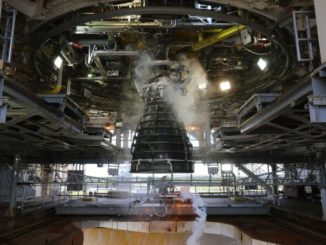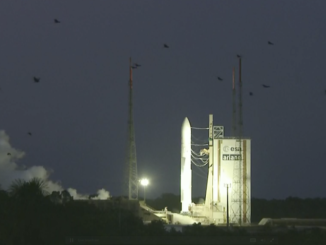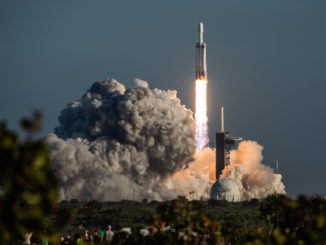
A Northrop Grumman Antares rocket rolled out to its launch pad on Virginia’s Eastern Shore early Tuesday, setting the stage for liftoff Saturday on a resupply flight to the International Space Station that will debut an upgraded launcher and Cygnus cargo vehicle capable of hauling heavier payloads into orbit.
Northrop Grumman’s next cargo delivery flight to the space station, designated NG-12, is the first in the company’s follow-on Commercial Resupply Services-2 contract with NASA. It follows 11 resupply launches under a previous CRS contract.
Riding a self-propelled transporter, the two-stage Antares rocket emerged from its Horizontal Integration Facility at Wallops Island, Virginia, around sunrise Tuesday to begin the mile-long journey to pad 0A at the Mid-Atlantic Regional Spaceport, a facility run by the Virginia Commercial Space Flight Authority.
After guiding the Antares rocket up the ramp at pad 0A, ground teams engaged a hydraulic lift to raise the 139-foot-tall (42.5-meter) rocket vertical later Tuesday to begin a series of preflight checks.
A combined systems test is planned Wednesday morning to verify interfaces between the Antares rocket, the Cygnus cargo carrier and the NASA-operated range at Wallops, according to Kurt Eberly, Northrop Grumman’s vice president of the Antares program.
Workers will then lower the Antares rocket back to a horizontal position and position a mobile clean room over the top of the launcher’s payload shroud. Technicians will open the top of the fairing to access the forward hatch of the Cygnus spacecraft for loading of time-sensitive cargo and experiments Friday morning.
The Antares team will close the Cygnus hatch, re-install the top of the Antares payload fairing, and raise the rocket vertical again late Friday in time to commence the five-hour launch countdown at 4:59 a.m. EDT (0859 GMT) Saturday, Eberly said.
The launch team will oversee final activation, readiness checks and filling of the Antares rocket’s first stage with kerosene and liquid oxygen propellants before liftoff at 9:59 a.m. EDT (1359 GMT) Saturday, roughly the moment that Earth’s rotation brings the Wallops launch site under the International Space Station’s ground track.

Saturday’s scheduled launch will mark the 11th flight of an Antares rocket since 2013, and sixth to fly in the Antares 230 configuration with two Russian-made RD-181 main engines, which replaced the AJ26 first stage engines used on first five Antares missions.
The AJ26s were modified decades-old NK-33 engines originally developed for the ill-fated Soviet-era N1 moon rocket, then kept in storage until their import to the United States in the 1990s. Investigators traced the cause of a dramatic Antares rocket explosion during a 2014 launch to an AJ26 engine, and officials from Orbital Sciences — now part of Northrop Grumman — elected to purchase newly-built RD-181 engines for future Antares flights.
The Antares rocket and Cygnus spacecraft, both owned and developed by Northrop Grumman, sport several upgrades debuting on Saturday’s flight.
The twin RD-181 engines on the Antares first stage will be able to fly at full throttle through the period of maximum aerodynamic pressure on the rocket, a phase of flight called Max-Q.
“On the last five flights with what we call the 230 configuration we throttled down at Max-Q for about 18 to 20 seconds, and starting with NG-12, we’re going to plan to fly at a 100 percent throttle setting throughout the first stage burn until we hit the maximum g-force limit, and then we throttle down at that point,” Eberly said Tuesday in an interview with Spaceflight Now.
The higher throttle setting is possible thanks to modifications to strengthen the Antares rocket’s first stage structure, which is made by Yuzhmash in Ukraine.
Eberly said Northrop Grumman also improved the “mass fraction” of the Antares first and second stages by removing unnecessary insulation, structures and pressurization systems. He said engineers also redesigned the Antares launch trajectory beginning with NG-12 to deliver the Cygnus cargo craft into a slightly lower orbit, an altitude difference the Cygnus will make up using its own engines.
The NG-12 mission is set to deliver some 8,200 pounds of supplies and experiments to the space station, nearly 10 percent more than the previous Antares/Cygnus flight. The cargo tally will set a new record for the heaviest payload launched by a commercial U.S. resupply ship.

After separation from the Antares rocket’s solid-fueled, U.S.-built second stage, the Cygnus spacecraft will unfurl its two fan-shaped solar arrays and begin maneuvers to set up for an automated rendezvous with the space station. The Cygnus supply ship will arrive at the station Monday, Nov. 4, assuming an on-time launch Saturday.
Under manual control by an astronaut, the space station’s Canadian-built robotic arm will capture the Cygnus spacecraft and berth it to a port on the orbiting lab’s Unity module to begin a stay scheduled to last more than two months.
Like the Antares, the Cygnus spacecraft set for launch Saturday features upgrades, said Frank DeMauro, vice president and general manager of Northrop Grumman’s space systems sector.
“Over time, we’re continually upgrading the system, not only to add more cargo but to add more capability to the spacecraft,” DeMauro told Spaceflight Now. “For CRS-2, I think the best way to describe it is we’re taking a step function up and even further increasing our focus on our ability to support science to the ISS.”
The Cygnus spacecraft for the NG-12 mission will launch with 10 mid-deck lockers for stowage and experiments, and six of the lockers will be powered throughout the flight to the space station. That’s an improvement from six lockers — and four powered lockers — on the NG-11 mission.
“Primarily, that’s the cargo that gets loaded in the final load because it’s the science that gets delivered to the ISS for the crew to run the experiments on,” DeMauro said.
The Cygnus spacecraft launching Saturday also carries additional communications and telemetry equipment to connect scientists with their experiments throughout the mission, from liftoff through arrival at the space station. In the past, scientists would be unable to communicate with their experiments until they were unloaded and connected inside the station.
Northrop Grumman and NASA have also established new life science laboratories close to the Wallops launch site, DeMauro said.
In another first for Cygnus, the NG-12 mission will dispose of two decommissioned experiments mounted outside the space station, a role previously reserved for SpaceX’s Dragon and Japan’s HTV cargo vehicles.
The Cygnus spacecraft will depart the space station in January with NASA’s Space Debris Sensor, an experiment that failed soon after its installation on the orbiting complex in 2018, and the European Space Agency’s SOLAR instrument, which monitored the sun’s output for more than nine years.
The two experiment packages will burn up during re-entry with the Cygnus spacecraft, once the Cygnus completes a series of CubeSat deployments after flying away from the station.
“That really helps NASA on the logistics side, cleaning out the disposal cargo from outside the ISS in additional to the critical role we play in getting rid of the disposal cargo from inside the ISS,” DeMauro said.
Northrop Grumman has named the next Cygnus spacecraft the “S.S. Alan Bean” after the Apollo and Skylab astronaut who died last year.

The Cygnus spacecraft from Northrop Grumman’s previous cargo flight, NG-11, has remained in orbit since leaving the space station Aug. 6 to begin an extended technology demonstration mission.
After Saturday’s launch, Northrop Grumman will operate two Cygnus vehicles in space at the same time. DeMauro said the company wants to demonstrate the dual-operations capability before deorbiting the NG-11 Cygnus to burn up during re-entry in the atmosphere.
The NG-11 Cygnus deployed several CubeSats in August, and since then has demonstrated the performance four control moment gyroscopes to govern the spacecraft’s pointing in space. The gyros reduce the supply ship’s fuel consumption, allowing it to remain in orbit for a longer mission.
“That experiment has gone very well,” DeMauro said. “We’ve shown very minimal fuel use.”
DeMauro said Northrop Grumman is eager to prove its ability to fly two Cygnus missions at the same time.
“That’s important for us because we want to demonstrate to NASA, other government agencies, as well as commercial companies that Cygnus does have the capability to carry on it all sorts or rideshare payloads or science that will benefit from the microgravity environment we can provide, being a free-flyer, and do that for an extended period of time and downlink the data from those experiments,” he said.
NASA has ordered six additional Cygnus cargo missions Northrop Grumman under the CRS-2 contract, according to DeMauro. All six are slated to launch on Antares rockets from Wallops Island, Virginia.
NASA has also committed to a minimum of six cargo missions with the agency’s other two CRS-2 transportation providers — SpaceX and Sierra Nevada Corp.
Northrop Grumman has evolved the Cygnus design over the last few years, first by lengthening its pressurized cargo module — built by Thales Alenia Space in Italy — then by expanding the supply ship’s power and telemetry capacity.
Engineers have developed the upgrades with a long-term goal of growing the Cygnus spacecraft’s market potential beyond space station resupply missions. The Cygnus now has a niche in deploying CubeSats and hosting standalone science experiments.
NASA has selected Northrop Grumman to develop a mini-habitation module derived from the Cygnus spacecraft for the space agency’s planned Gateway station in lunar orbit, a waypoint for astronauts on lunar landing missions in NASA’s Artemis program. And resupply vehicles based on the Cygnus spacecraft could ferry logistics to the Gateway in the future.
“We’ve always felt that Cygnus would be a great building block for the next generation of vehicles that go to the moon,” DeMauro said.
Earlier this year, NASA announced its selection of Northrop Grumman for a sole-source contract to build and launch the Habitation and Logistics Outpost, or HALO, module derived from the Cygnus spacecraft to join the Gateway station in 2023, a year before NASA hopes to attempt a crewed lunar landing.
The first piece of the Gateway, a power and propulsion element built by Maxar, is scheduled to launch in 2022.
DeMauro said HALO contract negotiations with NASA are ongoing, with discussions centered on the agency’s requirements for the habitation module, which will offer limited life support functions for astronauts on short-duration stints aboard the Gateway.
The HALO will also be designed for a longer lifetime than a typical Cygnus spacecraft.
Email the author.
Follow Stephen Clark on Twitter: @StephenClark1.



